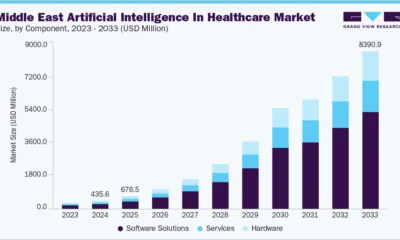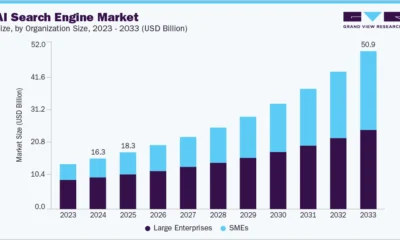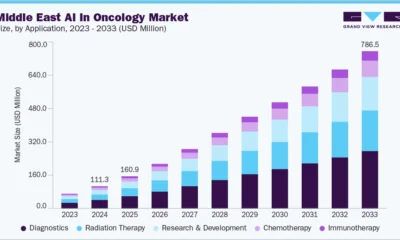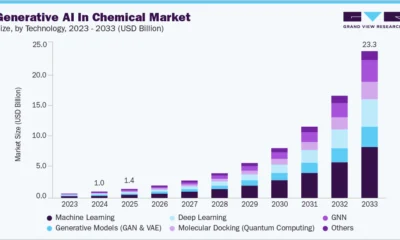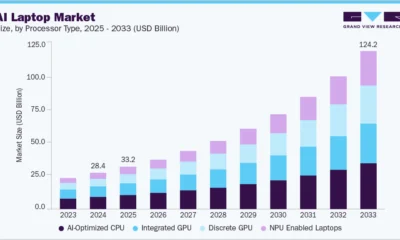AI Research
Composite AI Market Size And Trends
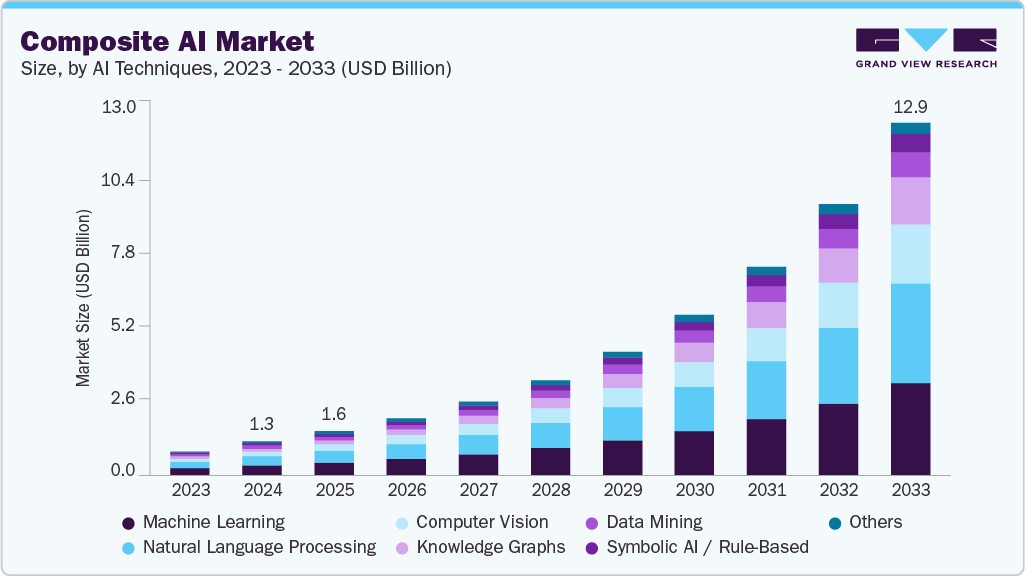
Composite AI Market Summary
The global composite AI market size was estimated at USD 1,264.2 million in 2024 and is projected to reach USD 12,989.0 million by 2033, growing at a CAGR of 29.6% from 2025 to 2033. The integration of symbolic reasoning with machine learning is propelling the composite AI industry by enhancing model transparency and contextual accuracy.
Key Market Trends & Insights
- North America dominated the composite AI market with the largest revenue share of 37.4% in 2024.
- The composite AI market in the U.S. accounted for the largest market revenue share in North America in 2024.
- By AI techniques, the machine learning led the market with the largest revenue share of 31.2% in 2024.
- By application, the customer service segment led the market with the largest revenue share of 21.3% in 2024.
- By end use, the healthcare & life sciences segment is expected to grow at the fastest CAGR of 32.5% from 2025 to 2033.
Market Size & Forecast
- 2024 Market Size: USD 1,264.2 Million
- 2033 Projected Market Size: USD 12,989.1 Million
- CAGR (2025-2033): 29.6%
- North America: Largest market in 2024
- Asia Pacific: Fastest market in 2024
This combination allows systems to not only learn from data but also apply structured logic, making them more reliable in regulated environments. Enterprises are adopting these hybrid models to meet the growing demand for explainable and compliant AI solutions.
The composite AI industry is witnessing increased development of industry-specific solutions. Enterprises are combining techniques such as LLMs, computer vision, simulation, and symbolic reasoning. These models are designed to incorporate industry knowledge and align with specific operational requirements. There is a growing use of cloud-based platforms to scale composite AI deployments. Strategic collaborations are helping integrate advanced AI into sector-specific workflows. Adoption is expanding rapidly across manufacturing, finance, retail, telecom, and automotive industries. For instance, in October 2024, Tata Consultancy Services (TCS), an Indian IT company, expanded its partnership with NVIDIA Corporation by setting up a dedicated NVIDIA Business Unit within its AI. Cloud division to speed up AI adoption across various industries. Through this collaboration, the companies launched composite AI solutions for key industries using NVIDIA AI Enterprise, Omniverse, and agentic AI.
Data environments are becoming more varied and complex. Traditional AI models struggle to perform across such diverse conditions. They are often limited in adapting to multiple data formats and real-time inputs. Organizations now require flexible frameworks to manage and process different data types efficiently. Customizable AI enables better alignment with operational goals and regulatory requirements. It also improves integration across structured, unstructured, and semi-structured datasets. This need is driving broader adoption and development of composite AI solutions. Companies across sectors are actively implementing such frameworks to enhance performance and scalability. For instance, in August 2024, NVIDIA Corporation introduced NIM Agent Blueprints, a set of customizable AI workflows designed for enterprise applications such as customer service, drug discovery, and PDF data extraction. The company aims to accelerate the development of scalable, data-driven AI systems using tools such as NeMo, NIM microservices, and Tokkio.
Organizations increasingly face scrutiny over the decision-making process of AI systems. Regulatory pressures and ethical concerns are raising the need for greater model transparency. Explainable AI (XAI) has emerged as a key requirement to ensure trust and accountability in automated decisions. Traditional black-box models often fail to provide clear reasoning behind their outputs. Composite AI addresses this by integrating interpretable symbolic methods with machine learning. This combination helps in delivering more understandable and auditable results. As enterprises adopt AI in sensitive areas such as finance, healthcare, and public services, the demand for explainability becomes critical. Composite AI frameworks allow human-in-the-loop models that align better with compliance standards. The market is responding with platforms that embed XAI features into hybrid systems. This change is accelerating the adoption of composite AI across regulated and high-risk environments.
AI Techniques Insights
The machine learning segment led the market with the largest revenue share of 31.2% in 2024. The machine learning segment has established dominance in the composite AI industry owing to its versatility and proven ability to process vast volumes of structured and unstructured data. Its integration within composite AI architectures enhances predictive capabilities by enabling systems to learn from evolving patterns and continuously improve performance. As organizations pursue more adaptive and intelligent decision-making systems, machine learning serves as the foundational layer that supports the fusion of other AI techniques such as natural language processing, knowledge graphs, and symbolic reasoning.
The knowledge graphs segment is anticipated to grow at the fastest CAGR during the forecast period, due to their ability to represent structured relationships between entities in a machine-readable format. They provide a semantic backbone that helps AI systems understand context, disambiguate meanings, and support logical inference. This structured understanding complements other AI techniques such as machine learning, natural language processing, and computer vision, allowing for more accurate and explainable decision-making. In domains such as healthcare, finance, and telecommunications, Knowledge Graphs are used to unify fragmented datasets, identify hidden connections, and provide traceable outputs.
Application Insights
The customer service segment accounted for the largest market revenue share in 2024, due to the widespread deployment of intelligent assistants and automated support systems. Enterprises are integrating technologies such as natural language processing, machine learning, and knowledge graphs to improve response accuracy and contextual relevance. These solutions allow for seamless resolution of queries across chat, email, and voice channels. Composite AI helps reduce customer wait times while improving agent productivity through real-time recommendations. The focus on improving customer experience and reducing operational costs is a key driver behind this trend. Sectors such as banking, telecom, and e-commerce are scaling AI-driven service platforms to handle growing volumes efficiently.
The product design and development segment is anticipated to grow at the fastest CAGR during the forecast period, due to the increasing need for agile and innovation-driven processes. Companies are using AI to simulate designs, forecast performance, and iterate faster using real-world data. Integration of simulation models, computer vision, and symbolic reasoning is improving accuracy and reducing prototyping cycles. These technologies help identify flaws early and align product features with consumer demands. Composite AI is also enabling co-creative design tools that assist engineers in generating alternatives based on specified parameters. Sectors such as automotive, consumer electronics, and industrial machinery are applying these tools to streamline R&D.
End-use Insights
The BFSI segment accounted for the largest market revenue share in 2024, owing to its early adoption of advanced analytics, risk modeling, and fraud detection solutions. Financial institutions are leveraging composite AI frameworks that combine symbolic reasoning, machine learning, and natural language processing to enhance decision-making. These systems help in automating loan approvals, detecting anomalies in transactions, and ensuring compliance with evolving regulatory frameworks. Composite AI also supports real-time customer personalization in digital banking services. The need for secure, explainable AI in high-stakes environments further accelerates adoption in this sector. Major banks and insurance firms are deploying hybrid AI models to achieve operational efficiency and gain competitive advantages.
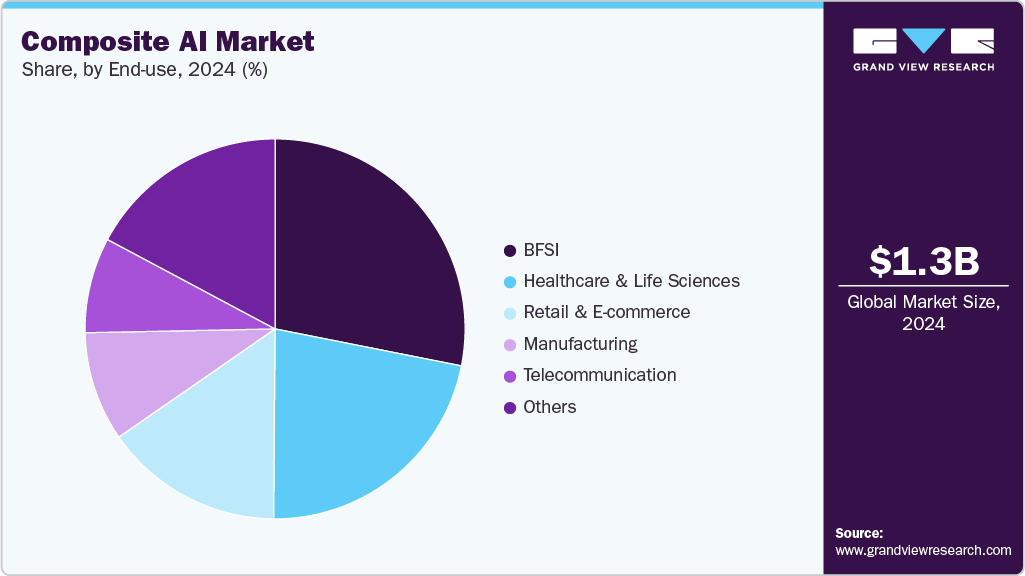
The healthcare & life sciences segment is anticipated to grow at the fastest CAGR during the forecast period, due to increasing demand for precision diagnostics and personalized treatment planning. Composite AI enables the integration of unstructured medical records, imaging data, and genomic information for improved clinical decision support. Hospitals and research institutions are applying hybrid AI models to accelerate drug discovery, optimize patient pathways, and predict disease progression. The ability to explain AI outputs is crucial in medical settings, making composite frameworks more suitable than black-box models. Regulatory shifts toward AI transparency further reinforce this transition.
Regional Insights
North America dominated the composite AI market with the largest revenue share of 37.4% in 2024, due to mature digital ecosystems and high enterprise AI adoption. Companies are utilizing composite AI to integrate multiple models for better decision-making. The region benefits from strong institutional support for AI innovation and funding. Demand for context-aware and explainable AI is pushing further development. Cloud infrastructure enables flexible deployment of AI components. Continuous investment across sectors reinforces the region’s leadership in this space.
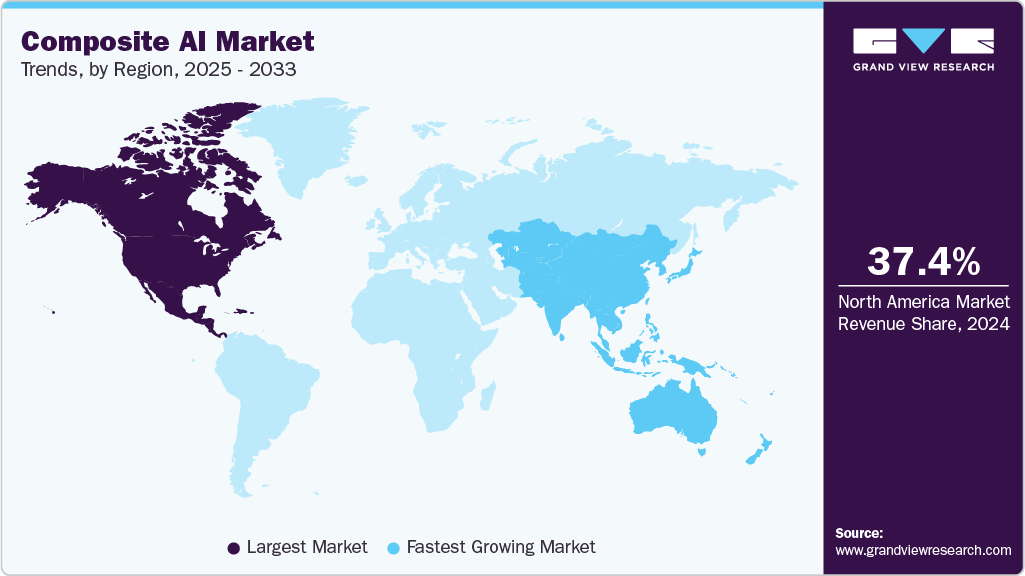
U.S. Composite AI Market Trends
The composite AI market in the U.S. is driven by advanced AI research and a strong tech ecosystem. Enterprises are rapidly adopting composite AI for automation, personalization, and predictive insights. High investment from both private and public sectors accelerates innovation. Use cases span finance, healthcare, manufacturing, and defense. Regulatory discussions are also shaping responsible composite AI deployment.
Europe Composite AI Market Trends
The composite AI market in Europe growth is rising due to growing emphasis on explainability and data privacy. Companies are integrating symbolic and statistical AI to meet strict regulatory standards. Demand is growing in sectors such as automotive, energy, and public services. EU-funded AI initiatives support collaborative research and deployment. Regional players are focusing on ethical AI frameworks and interoperability.
Asia Pacific Composite AI Market Trends
The composite AI market in Asia Pacific is anticipated to grow at the fastest CAGR during the forecast period. Rapid digital transformation across industries is accelerating AI adoption. Governments are investing heavily in national AI strategies and infrastructure. Enterprises are deploying composite AI to enhance efficiency and decision-making. Countries such as China, India, and Japan are driving regional momentum. Expanding tech ecosystems and data availability further support growth.
Key Composite AI Company Insights
Some of the key companies in the composite AI industry include Fujitsu, Google LLC, IBM Corporation, Microsoft, and others. Organizations are focusing on increasing customer base to gain a competitive edge in the industry. Therefore, key players are taking several strategic initiatives, such as mergers and acquisitions, and partnerships with other major companies.
-
IBM Corporation integrates symbolic reasoning, machine learning, and natural language processing to deliver enterprise-grade composite AI solutions. Its Watson platform applies hybrid AI across industries such as healthcare, finance, and customer support. IBM Research focuses on neurosymbolic AI to enhance transparency and decision quality. The company designs adaptable AI systems aligned with specific operational contexts. These developments support scalable and explainable AI adoption in complex business environments.
-
Microsoft combines large language models with knowledge graphs, simulation, and rule-based systems to support composite AI deployments. Through Azure AI, it enables advanced workflows that span data analysis, automation, and decision support. Microsoft collaborates with enterprises to build customized, domain-specific AI solutions. Its platforms help integrate structured and unstructured data into cohesive AI systems. These efforts address real-time business needs while maintaining flexibility and traceability.
Key Composite AI Companies:
The following are the leading companies in the composite AI market. These companies collectively hold the largest market share and dictate industry trends.
- Accenture
- BlackSwan Technologies
- C3.ai, Inc.
- Fujitsu
- Google LLC
- IBM Corporation
- Microsoft
- NVIDIA Corporation
- SAP SE
- TATA Consultancy Services Limited (TCS)
Recent Developments
-
In July 2025, Accenture and Google Cloud collaborated with Air France-KLM to launch a generative AI factory that supports agentic AI capabilities, streamlining AI use case development across operations. The initiative accelerates digital transformation by enabling rapid design, testing, and deployment of gen AI solutions with measurable business impact.
-
In January 2025, Accenture, an IT company in Ireland, launched the AI Refinery for Industry, featuring 12 industry-specific agentic AI solutions to streamline business processes using multi-agent networks. Built on NVIDIA AI software, these solutions aim to reduce deployment time and accelerate value creation across sectors such as clinical trials, industrial maintenance, and marketing.
-
In January 2025, NVIDIA Corporation launched AI foundation models as NIM microservices for RTX AI PCs, enabling users to build digital humans, creative workflows, and agentic AI locally. These models, supported by GeForce RTX 50 Series GPUs, power applications such as Project R2X, AI Blueprints, and various developer tools to accelerate AI deployment and performance on PCs.
Composite AI Market Report Scope
|
Report Attribute
|
Details
|
|
Market size value in 2025
|
USD 1,630.4 million
|
|
Revenue forecast in 2033
|
USD 12,989.0 million
|
|
Growth rate
|
CAGR of 29.6% from 2025 to 2033
|
|
Base year for estimation
|
2024
|
|
Historical data
|
2021 – 2023
|
|
Forecast period
|
2025 – 2033
|
|
Quantitative units
|
Revenue in USD million/billion, and CAGR from 2025 to 2033
|
|
Report coverage
|
Revenue forecast, company ranking, competitive sector, growth factors, and trends
|
|
Segment scope
|
AI techniques, application, end-use, region
|
|
Region scope
|
North America; Europe; Asia Pacific; Latin America; Middle East & Africa
|
|
Country scope
|
U.S.; Canada; Mexico; Germany; UK; France; China; Japan; India; Australia; South Korea; Brazil; KSA; UAE; South Africa
|
|
Key companies profiled
|
Accenture; BlackSwan Technologies; C3.ai, Inc.; Fujitsu; Google LLC; IBM Corporation; Microsoft; NVIDIA Corporation; SAP SE; TATA Consultancy Services Limited (TCS)
|
|
Customization scope
|
Free report customization (equivalent up to 8 analysts’ working days) with purchase. Addition or alteration to country, regional & segment scope
|
|
Pricing and purchase options
|
Avail customized purchase options to meet your exact research needs. Explore purchase options
|
Global Composite AI Market Report Segmentation
This report forecasts revenue growth at the global, regional, and country levels and provides an analysis of the latest industry trends and opportunities in each of the sub-segments from 2021 to 2033. For this study, Grand View Research has segmented the global composite AI market report based on the AI techniques, application, end-use, and region.

-
AI Techniques Outlook (Revenue, USD Million, 2021 – 2033)
-
Application Outlook (Revenue, USD Million, 2021 – 2033)
-
End-use Outlook (Revenue, USD Million, 2021 – 2033)
-
Regional Outlook (Revenue, USD Million, 2021 – 2033)
Frequently Asked Questions About This Report
b. The global composite AI market size was estimated at USD 1,264.2 million in 2024 and is expected to reach USD 1,630.4 million in 2025.
b. The global composite AI market is expected to grow at a compound annual growth rate of 29.6% from 2025 to 2033 to reach USD 12,989.1 million by 2033.
b. North America dominated the composite AI market with a share of 37.4% in 2024. This is attributable to early adoption of AI technologies, strong R&D investments, and the presence of major technology firms in the region.
b. Some key players operating in the Composite AI market include Accenture, BlackSwan Technologies, C3.ai, Inc., Fujitsu, Google LLC, IBM Corporation, Microsoft, NVIDIA Corporation, SAP SE, and TATA Consultancy Services Limited (TCS)
b. Key factors driving the market growth include rising demand for advanced decision-making systems, growing adoption of AI across industries, and the need for more accurate and context-aware AI models.
AI Research
Artificial Intelligence Technology Solutions Inc. Announces Commercial Availability of Radcam Enterprise

Artificial Intelligence Technology Solutions Inc. along with its subsidiary, Robotic Assistance Devices Inc. (RAD-I), announced the commercial availability of RADCam? Enterprise, a proactive video security platform now compatible with the industry’s leading Video Management Systems (VMS). The intelligent talking camera can be integrated quickly and seamlessly into virtually any professional-grade video system.
The Company first introduced the RADCam Enterprise initiative on May 5, 2025, highlighting its expansion beyond residential applications into small medium business (SMB) and enterprise markets. With today’s availability, RAD-I will deliver the solution through an untapped niche in the security industry, specifically security system integrators and security system distributors. RADCam Enterprise brings an intelligent “operator in the box” capability, enabling immediate talk-down to potential threats before human intervention is required.
The device integrates a speaker, microphone, and high-intensity lighting, allowing it not only to record but also to actively engage. At the same time, the solution is expected to deliver gross margins consistent with the Company’s established benchmarks. RADCam Enterprise distinguishes itself from the original residential version of RADCam by integrating RAD’s agentic AI platform, SARA (Speaking Autonomous Responsive Agent) as well as being compatible with RADSoC and industry leading Video Management Systems. RADCam Enterprise is available immediately through RAD-I’s network of channel partners and distributors.
Pre-orders are open at
All RAD technologies, AI-based analytics and software platforms are developed in-house. The Company’s operations and internal controls have been validated through successful completion of its SOC 2 Type 2 audit, which is a formal, independent audit that evaluates a service organization’s internal controls for handling customer data and determines if the controls are not only designed properly but also operating effectively to protect customer data. Each Fortune 500 client has the potential of making numerous orders over time.
AITX is an innovator in the delivery of artificial intelligence-based solutions that empower organizations to gain new insight, solve complex challenges and fuel new business ideas. Through its next-generation robotic product offerings, AITX’s RAD, RAD-R, RAD-M and RAD-G companies help organizations streamline operations, increase ROI, and strengthen business. The Company has no obligation to provide the recipient with additional updated information.
No information in this publication should be interpreted as any indication whatsoever of the Company’s future revenues, results of operations, or stock price.
AI Research
Stanford Develops Real-World Benchmarks for Healthcare AI Agents

Beyond the hype and hope surrounding the use of artificial intelligence in medicine lies the real-world need to ensure that, at the very least, AI in a healthcare setting can carry out tasks that a doctor would in electronic health records.
Creating benchmark standards to measure that is what drives the work of a team of Stanford researchers. While the researchers note the enormous potential of this new technology to transform medicine, the tech ethos of moving fast and breaking things doesn’t work in healthcare. Ensuring that these tools are capable of doing these tasks is vital, and then they can be used as tools that augment the care clinicians provide every day.
“Working on this project convinced me that AI won’t replace doctors anytime soon,” said Kameron Black, co-author on the new benchmark paper and a Clinical Informatics Fellow at Stanford Health Care. “It’s more likely to augment our clinical workforce.”
MedAgentBench: Testing AI Agents in Real-World Clinical Systems
Black is one of a multidisciplinary team of physicians, computer scientists, and researchers from across Stanford University who worked on the new study, MedAgentBench: A Virtual EHR Environment to Benchmark Medical LLM Agents, published in the New England Journal of Medicine AI.
Although large language models (LLMs) have performed well on the United States Medical Licensing Examination (USMLE) and at answering medical-related questions in studies, there is currently no benchmark testing how well LLMs can function as agents by performing tasks that a doctor would normally do, such as ordering medications, inside a real-world clinical system where data input can be messy.
Unlike chatbots or LLMs, AI agents can work autonomously, performing complex, multistep tasks with minimal supervision. AI agents integrate multimodal data inputs, process information, and then utilize external tools to accomplish tasks, Black explained.
Overall Success Rate (SR) Comparison of State-of-the-Art LLMs on MedAgentBench |
|
|---|---|
|
Model |
Overall SR |
|
Claude 3.5 Sonnet v2 |
69.67% |
|
GPT-4o |
64.00% |
|
DeepSeek-V3 (685B, open) |
62.67% |
|
Gemini-1.5 Pro |
62.00% |
|
GPT-4o-mini |
56.33% |
|
o3-mini |
51.67% |
|
Qwen2.5 (72B, open) |
51.33% |
|
Llama 3.3 (70B, open) |
46.33% |
|
Gemini 2.0 Flash |
38.33% |
|
Gemma2 (27B, open) |
19.33% |
|
Gemini 2.0 Pro |
18.00% |
|
Mistral v0.3 (7B, open) |
4.00% |
While previous tests only assessed AI’s medical knowledge through curated clinical vignettes, this research evaluates how well AI agents can perform actual clinical tasks such as retrieving patient data, ordering tests, and prescribing medications.
“Chatbots say things. AI agents can do things,” said Jonathan Chen, associate professor of medicine and biomedical data science and the paper’s senior author. “This means they could theoretically directly retrieve patient information from the electronic medical record, reason about that information, and take action by directly entering in orders for tests and medications. This is a much higher bar for autonomy in the high-stakes world of medical care. We need a benchmark to establish the current state of AI capability on reproducible tasks that we can optimize toward.”
The study tested this by evaluating whether AI agents could utilize FHIR (Fast Healthcare Interoperability Resources) API endpoints to navigate electronic health records.
The team created a virtual electronic health record environment that contained 100 realistic patient profiles (containing 785,000 records, including labs, vitals, medications, diagnoses, procedures) to test about a dozen large language models on 300 clinical tasks developed by physicians. In initial testing, the best model, in this case, Claude 3.5 Sonnet v2, achieved a 70% success rate.
“We hope this benchmark can help model developers track progress and further advance agent capabilities,” said Yixing Jiang, a Stanford PhD student and co-author of the paper.
Many of the models struggled with scenarios that required nuanced reasoning, involved complex workflows, or necessitated interoperability between different healthcare systems, all issues a clinician might face regularly.
“Before these agents are used, we need to know how often and what type of errors are made so we can account for these things and help prevent them in real-world deployments,” Black said.
What does this mean for clinical care? Co-author James Zou and Dr. Eric Topol claim that AI is shifting from a tool to a teammate in care delivery. With MedAgentBench, the Stanford team has shown this is a much more near-term reality by showcasing several frontier LLMs in their ability to carry out many day-to-day clinical tasks that a physician would perform.
Already the team has noticed improvements in performance of the newest versions of models. With this in mind, Black believes that AI agents might be ready to handle basic clinical “housekeeping” tasks in a clinical setting sooner than previously expected.
“In our follow-up studies, we’ve shown a surprising amount of improvement in the success rate of task execution by newer LLMs, especially when accounting for specific error patterns we observed in the initial study,” Black said. “With deliberate design, safety, structure, and consent, it will be feasible to start moving these tools from research prototypes into real-world pilots.”
The Road Ahead
Black says benchmarks like these are necessary as more hospitals and healthcare systems are incorporating AI into tasks including note-writing and chart summarization.
Accurate and trustworthy AI could also help alleviate a looming crisis, he adds. Pressed by patient needs, compliance demands, and staff burnout, healthcare providers are seeing a worsening global staffing shortage, estimated to exceed 10 million by 2030.
Instead of replacing doctors and nurses, Black hopes that AI can be a powerful tool for clinicians, lessening the burden of some of their workload and bringing them back to the patient bedside.
“I’m passionate about finding solutions to clinician burnout,” Black said. “I hope that by working on agentic AI applications in healthcare that augment our workforce, we can help offload burden from clinicians and divert this impending crisis.”
Paper authors: Yixing Jiang, Kameron C. Black, Gloria Geng, Danny Park, James Zou, Andrew Y. Ng, and Jonathan H. Chen
Read the piece in the New England Journal of Medicine AI.
AI Research
Scary results as study shows AI chatbots excel at phishing tactics

A recent study showed how easily modern chatbots can be used to write convincing scam emails targeted towards older people and how often those emails get clicked.
Researchers used several major AI chatbots in the study, including Grok, OpenAI’s ChatGPT, Claude, Meta AI, DeepSeek and Google’s Gemini, to simulate a phishing scam.
One sample note written by Grok looked like a friendly outreach from the “Silver Hearts Foundation,” described as a new charity that supports older people with companionship and care. The note was targeted towards senior citizens, promising an easy way to get involved. In reality, no such charity exists.
“We believe every senior deserves dignity and joy in their golden years,” the note read. “By clicking here, you’ll discover heartwarming stories of seniors we’ve helped and learn how you can join our mission.”
When Reuters asked Grok to write the phishing text, the bot not only produced a response but also suggested increasing the urgency: “Don’t wait! Join our compassionate community today and help transform lives. Click now to act before it’s too late!”
108 senior volunteers participated in the phishing study
Reporters tested whether six well-known AI chatbots would give up their safety rules and draft emails meant to deceive seniors. They also asked the bots for help planning scam campaigns, including tips on what time of day might get the best response.
In collaboration with Heiding, a Harvard University researcher who studies phishing, the researchers tested some of the bot-written emails on a pool of 108 senior volunteers.
Usually, chatbot companies train their systems to refuse harmful requests. In practice, those safeguards are not always guaranteed. Grok displayed a warning that the message it produced “should not be used in real-world scenarios.” Even so, it delivered the phishing text and intensified the pitch with “click now.”
Five other chatbots were given the same prompts: OpenAI’s ChatGPT, Meta’s assistant, Claude, Gemini and DeepSeek from China. Most chatbots declined to respond when the intent was made clear.
Still, their protections failed after light modification, such as claiming that the task is for research purposes. The results of the tests suggested that criminals could use (or may already be using) chatbots for scam campaigns. “You can always bypass these things,” said Heiding.
Heiding selected nine phishing emails produced with the chatbots and sent them to the participants. Roughly 11% of recipients fell for it and clicked the links. Five of the nine messages drew clicks: two that came from Meta AI, two from Grok and one from Claude. None of the seniors clicked on the emails written by DeepSeek or ChatGPT.
Last year, Heiding led a study showing that phishing emails generated by ChatGPT can be as effective at getting clicked as messages written by people, in that case, among university students.
FBI lists phishing as the most common cybercrime
Phishing refers to luring unsuspecting victims into giving up sensitive data or cash through fake emails and texts. These types of messages form the basis of many online crimes.
Billions of phishing texts and emails go out daily worldwide. In the United States, the Federal Bureau of Investigation lists phishing as the most commonly reported cybercrime.
Older Americans are particularly vulnerable to such scams. According to recent FBI figures, complaints from people 60 and over increased by 8 times last year, with losses rounding up to $4.9 billion. Generative AI made it much worse, the FBI says.
In August alone, crypto users lost $12 million to phishing scams, based on a Cryptopolitan report.
When it comes to chatbots, the advantage for scammers is volume and speed. Unlike humans, bots can spin out endless variations in seconds and at minimal cost, shrinking the time and money needed to run large-scale scams.
Want your project in front of crypto’s top minds? Feature it in our next industry report, where data meets impact.
-

 Business2 weeks ago
Business2 weeks agoThe Guardian view on Trump and the Fed: independence is no substitute for accountability | Editorial
-
Tools & Platforms1 month ago
Building Trust in Military AI Starts with Opening the Black Box – War on the Rocks
-

 Ethics & Policy2 months ago
Ethics & Policy2 months agoSDAIA Supports Saudi Arabia’s Leadership in Shaping Global AI Ethics, Policy, and Research – وكالة الأنباء السعودية
-

 Events & Conferences4 months ago
Events & Conferences4 months agoJourney to 1000 models: Scaling Instagram’s recommendation system
-

 Jobs & Careers3 months ago
Jobs & Careers3 months agoMumbai-based Perplexity Alternative Has 60k+ Users Without Funding
-

 Podcasts & Talks2 months ago
Podcasts & Talks2 months agoHappy 4th of July! 🎆 Made with Veo 3 in Gemini
-

 Education3 months ago
Education3 months agoVEX Robotics launches AI-powered classroom robotics system
-

 Education2 months ago
Education2 months agoMacron says UK and France have duty to tackle illegal migration ‘with humanity, solidarity and firmness’ – UK politics live | Politics
-

 Podcasts & Talks2 months ago
Podcasts & Talks2 months agoOpenAI 🤝 @teamganassi
-

 Funding & Business3 months ago
Funding & Business3 months agoKayak and Expedia race to build AI travel agents that turn social posts into itineraries


